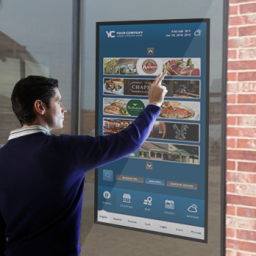As individuals continue to utilize mobile devices as their primary source of information, they increasingly expect instant access to information at the sight (or touch) of a screen. As a result, consumers are much more responsive to information displayed digitally. Businesses and organizations are responding to this cultural shift by turning to digital solutions which allow increased flexibility, the collection of robust data and greater ROI than traditional advertising signage.
Engage with Customers
With the increasing power of digital signage technology, business owners can showcase a targeted range of goods to each customer, feature loyalty promotions and drive users to the content they want. “Digital signage is changing the way customers engage with brands,” said Chris Gilder, CEO of kiosk technology provider Meridian Kiosks.
Digital signage provides security to keep user information safe and offer the ability to load content in multiple formats such as video, photo, text or audio. However, there are differentiators between Interactive Digital Signage and Display to consider. Interactive digital signage utilizes a touchscreen and more complex software development, which can be more costly depending on the requirements of the signage. The interactive touchscreen sometimes needs a more in-depth customized design and development phase, which requires more maintenance and upkeep. Display Digital Signage can be purchased at a lower price point due to its less complex development phase and simpler maintenance.
The greatest difference between interactive and display is how users interact with the signage. Display digital signage is great for locations where the target audience is either sitting or standing for prolonged periods of time. Display Digital Signage scrolls messages so consumers view the message as it appears in the looped cycle- not necessarily when the consumer might need it; and due to the repetitive nature of scrolling text and images, the message has the potential to get lost if the viewer tunes out. The lure of interactive digital signage is that it lets the viewer engage; consumers can search for the item or information they need and get it without waiting for the information to re-appear on a scrolling display. “One of the big problems with display digital signage is that there’s so much noise in digital media that without interaction people are less likely to take notice,” said Gilder.
Interactive Digital Signage Content
Every medium used to convey information needs engaging content, and digital signage is no different. From the words used to the font chosen, digital signage has certain nuances and size constrictions that need be considered in order to successfully reach the target audience.
Text should be legible up close and from a distance. Consider using black and white text for optimal legibility and include color through images and headlines. Dark text should be used on a light background or visa versa to ensure plenty of contrast on the screen. “I recommend using a sans-serif font for digital signage,” said Gilder. When using a slideshow type screen with scrolling images, slow down the timing in order to allow the audience to consume the information. Often the screen frequency is too fast, leaving the viewer frustrated and unable to digest all of the content. However, leaving the screen for too long can be equally damaging to the message.
Remember that the screen is silent so text and images must be dynamic. If brand imagery is being used, keep brand icon usage consistent with usage in other media. Keep brand colors running throughout the screens to keep brand recognition throughout the presentation. “Use motion sparingly, too much motion can have a detrimental effect on the message by distracting the viewer,” said Gilder. When using motion, keep a logo or text box static as a grounding point on the screen. Motion on the periphery is more subtle than motion in the middle of the line of sight. The most important features should be static.
Interactive Digital Signage Location

In a retail setting, install screens promoting a certain product near that product. Store windows can also be a great location for digital signage as they can be used during store hours to draw customers in, and after the business is closed to capture additional attention. Locations, where there is too much ambient light, can make content difficult to see, as sunlight can wash out the image on the screen. A common screen placement mistake businesses continue to make is hanging the screen too high or too low. Customers walking through a store are focused on the goods in front of them. They may not look up or down, missing the signage entirely.
Interactive Digital Signage Software
Choosing the right software platform and application is crucial to a successful digital signage deployment. The software determines everything from security to monitoring to integration – and ultimately, to the customer experience. While both the software platform and the software application are crucial to the success of a kiosk or digital signage deployment, it’s important to remember the differences between the two and what role each plays.
The software platform hardens the operating system and allows for the integration of multiple peripheral components; it will also provide a “heartbeat” to a remote server and allow businesses to monitor devices remotely. A software application, on the other hand, is created specifically for the kiosk experience and will allow a user to interact with a graphic user interface (GUI), as well as multiple components, such as printers, cameras, scanners, etc. Software platforms are often available as off-the-shelf solutions, but a software platform alone usually only offers a secure browser for viewing whitelisted web content. The kiosk-specific application is what creates a great customer experience.
For retailers looking for a simple digital signage software to engage with their consumers, off-the-shelf software solutions are gaining popularity. A true off-the-shelf software solution has many benefits. They are designed for ease of use and often do not require an understanding of difficult computer programming. This makes it easy for even the smallest of businesses to support. Off-the-shelf applications offer ways to incorporate a company’s branding and have reasonable technical requirements that cover a wide range of hardware and operating systems. In addition, a comprehensive software solution can collect analytics to measure ROI and effectiveness of content. The collected data can be used to create more targeted content for visitors and increased ROI.
“Engaging content on digital display increases consumer awareness and offers new channels for businesses to expand their consumer reach,” said Gilder. Interactive digital signage continues to gain popularity in retail for multiple use cases, including wayfinding, digital advertising, analytics and customer loyalty. Retail digital signage is providing value to businesses by enhancing customer experience and providing a revenue-generating advertising solution.




